Preparation of Nano-Sized C-S-H and Its Acceleration Mechanism on Portland Cement Hydration at Different Temperatures
Abstract
:1. Introduction
2. Materials and Experiments
2.1. Raw Materials
2.2. Preparation of Nano C-S-H
2.3. Preparation of Mortar, Paste and Concrete
2.4. Test Methods
3. Results and Discussion
3.1. Stability and Size of Nano-Sized C-S-H Suspension
3.2. Hydration Process of Cement
3.3. Early Strength Enhancement of Nano C-S-H
3.4. Early Strength Enhancement of Nano-Sized C-S-H at 10 °C
4. Conclusions
- Nano-sized C-S-H with semi-crystalline structures were prepared. The average size of nano-sized C-S-H increased with an increase in the theoretical concentration, and a slight precipitation in the suspension was observed when the theoretical concentration was 2%. The D(90) values of S1 and S2 are 105.2 nm and 117.3 nm, respectively, and the average sizes of S1 and S2 are 154.2 nm and 181.3 nm, respectively.
- Nano-sized C-S-H promotes the hydration process of cement mainly by accelerating the reaction degree of C3S, especially within the first 24 h of casting. The 8 h, 16 h, 24 h Ca(OH)2 contents in hydrated cement increased by 62.9%, 89.5% and 91.2%, respectively.
- The 8 h, 16 h and 24 h compressive strength of mortars containing nano-sized C-S-H increased by 176.0%, 145.6% and 43.9%, respectively, compared with the reference mortar, while the 3 d flexural strength and compressive strength show a slightly decrease.
- Nano-sized C-S-H improved the hydration degree of Portland cement cured at 10 °C, but the enhancement was much lower than for that cured at 20 °C.
Author Contributions
Funding
Institutional Review Board Statement
Informed Consent Statement
Data Availability Statement
Conflicts of Interest
References
- Ma, C.; Peng, J.; Zhou, H.; Zhou, R.; Ren, W.; Du, Y. An effective method for preparing high early-strength cement-based materials: The effects of direct electric curing on Portland cement. J. Build. Eng. 2021, 43, 102485. [Google Scholar] [CrossRef]
- Cui, S.; Liu, P.; Su, J.; Cui, E.; Guo, C.; Zhu, B. Experimental study on mechanical and microstructural properties of cement-based paste for shotcrete use in high-temperature geothermal environment. Constr. Build. Mater. 2018, 174, 603–612. [Google Scholar] [CrossRef]
- Liu, B.; Xie, Y.; Jian, L. Influence of steam curing on the compressive strength of concrete containing supplementary cementing materials. Cem. Concr. Res. 2005, 35, 994–998. [Google Scholar] [CrossRef]
- Ba, M.F.; Qian, C.X.; Guo, X.J.; Han, X.Y. Effects of steam curing on strength and porous structure of concrete with low water/binder ratio. Constr. Build. Mater. 2010, 25, 123–128. [Google Scholar] [CrossRef]
- Vodák, F.; Trtık, K.; Kapičková, O. The effect of temperature on strength–porosity relationship for concrete. Constr. Build. Mater. 2004, 18, 529–534. [Google Scholar] [CrossRef]
- Ho, D.; Chua, C.W.; Tam, C.T. Steam-cured concrete incorporating mineral admixtures. Cem. Concr. Res. 2003, 33, 595–601. [Google Scholar] [CrossRef]
- Lin, M.; Wang, W.; Yong, L.I. Preparation of Inorganic Compound Early Strength Agent and Its Effect on Properties of Cement Stabilized Macadam Material. Mater. Rev. 2018, 32, 511–516. (In Chinese) [Google Scholar]
- Mehta, P.K.; Monteiro, P. Concrete: Microstructure, Properties, and Materials; McGraw-Hill Education: New York, NY, USA, 2014; pp. 148–162. [Google Scholar]
- Íková, M.K.; Toková, A.E.; Oravec, J.; Luptáková, A. Investigation of the Precipitates on the Concrete Surface due to Sulphate Exposure. Sel. Sci. Pap.—J. Civ. Eng. 2017, 11, 31–38. [Google Scholar]
- Sobolev, K.; Gutiérrez, M.F. How Nanotechnology Can Change the Concrete World. In Progress in Nanotechnology; The American Ceramic Society: Westerville, OH, USA, 2014. [Google Scholar]
- Li, W.; Huang, Z.; Cao, F.; Wan, S. Effects of nano-silica and nano-limestone on flowability and mechanical properties of ultra-high-performance concrete matrix. Constr. Build. Mater. 2015, 95, 366–374. [Google Scholar] [CrossRef]
- Wu, Z.; Shi, C.; Khayat, K.H.; Wan, S. Effects of different nanomaterials on hardening and performance of ultra-high strength concrete (UHSC). Cem. Concr. Compos. 2016, 70, 24–34. [Google Scholar] [CrossRef]
- Gu, X.; Tan, H.; He, X.; Zhang, J.; Li, M.; Su, Y.; Yang, J. Nano C-S-H seeds prepared from ground granulated blast-furnace slag-carbide slag and its application in Portland cement. Constr. Build. Mater. 2022, 329, 127204. [Google Scholar] [CrossRef]
- Wang, L.; Guo, F.; Lin, Y.; Yang, H.; Tang, S. Comparison between the effects of phosphorous slag and fly ash on the C-S-H structure, long-term hydration heat and volume deformation of cement-based materials. Constr. Build. Mater. 2020, 250, 118807. [Google Scholar] [CrossRef]
- Li, L.; Zhang, Y.; Shi, Y.; Xue, Z.; Cao, M. Surface Cracking and Fractal Characteristics of Cement Paste after Exposure to High Temperatures. Fractal Fract. 2022, 6, 465. [Google Scholar] [CrossRef]
- Hasanzadeh, A.; Shooshpasha, I. Influence of Silica Fume on the Geotechnical Characteristics of Cemented Sand. Geotech. Geol. Eng. 2020, 38, 6295–6312. [Google Scholar] [CrossRef]
- Cui, K.; Chang, J. Hydration, reinforcing mechanism, and macro performance of multi-layer graphene-modified cement composites. J. Build. Eng. 2022, 57, 104880. [Google Scholar] [CrossRef]
- Wang, L.; Jin, M.; Zhou, S.; Tang, S.; Lu, X. Investigation of microstructure of C-S-H and micro-mechanics of cement pastes under NH4NO3 dissolution by 29 Si MAS NMR and microhardness. Measurement 2021, 185, 110019. [Google Scholar] [CrossRef]
- John, E.; Matschei, T.; Stephan, D. Nucleation seeding with calcium silicate hydrate—A review. Cem. Concr. Res. 2018, 113, 74–85. [Google Scholar] [CrossRef]
- Kanchanason, V.; Plank, J. Role of pH on the structure, composition and morphology of C-S-H–PCE nanocomposites and their effect on early strength development of Portland cement. Cem. Concr. Res. 2017, 102, 90–98. [Google Scholar] [CrossRef]
- Wang, Y.; Lu, H.; Wang, J.; He, H. Effects of Highly Crystalized Nano C-S-H Particles on Performances of Portland Cement Paste and Its Mechanism. Crystals 2020, 10, 816. [Google Scholar] [CrossRef]
- Thomas, J.J.; Jennings, H.M.; Chen, J.J. Influence of nucleation seeding on the hydration mechanisms of tricalcium silicate and cement. J. Phys. Chem. C 2009, 113, 4327–4334. [Google Scholar] [CrossRef]
- Wang, F.; Kong, X.; Jiang, L.; Wang, D. The acceleration mechanism of nano-C-S-H particles on OPC hydration. Constr. Build. Mater. 2020, 249, 118734. [Google Scholar] [CrossRef]
- John, E.; Epping, J.D.; Stephan, D. The influence of the chemical and physical properties of C-S-H seeds on their potential to accelerate cement hydration. Constr. Build. Mater. 2019, 228, 116723. [Google Scholar] [CrossRef]
- Nicoleau, L. Accelerated growth of calcium silicate hydrates: Experiments and simulations. Cem. Concr. Res. 2011, 41, 1339–1348. [Google Scholar] [CrossRef]
- Feng, Q.; Mao, Y.; Peng, Z.; Zheng, Y.; Wu, J. Preparation and Properties of Low-Temperature Early Strength Material for Nano-C-S-H Gel Seed. Arab. J. Sci. Eng. 2022, 47, 5567–5575. [Google Scholar] [CrossRef]
- Zhu, S.; Fang, Y.; Guo, Y.; Ma, X. Preparation of nano-calcium silicate hydrate and its application in concrete. IOP Conf. Ser. Mater. Sci. Eng. 2019, 631, 361–365. [Google Scholar] [CrossRef]
- Hubler, M.H.; Thomas, J.J.; Jennings, H.M. Influence of nucleation seeding on the hydration kinetics and compressive strength of alkali activated slag paste. Cem. Concr. Res. 2011, 41, 842–846. [Google Scholar] [CrossRef]
- Cuesta, A.; Morales-Cantero, A.; De la Torre, A.G.; Aranda, M.A. Recent advances in C-S-H nucleation seeding for improving cement performances. Materials 2023, 16, 1462. [Google Scholar] [CrossRef]
- Land, G.; Stephan, D. Controlling cement hydration with nanoparticles. Cem. Concr. Compos. 2015, 57, 64–67. [Google Scholar] [CrossRef]
- Kong, D.; He, G.; Pan, H.; Weng, Y.; Du, N.; Sheng, J. Influences and mechanisms of nano-C-S-H gel addition on fresh properties of the cement-based materials with sucrose as retarder. Materials 2020, 13, 2345. [Google Scholar] [CrossRef]
- Zhu, H.; Zhang, M.; Zou, F.; Wang, F.; Hu, C. Calcium-silicate-hydrates/polycarboxylate ether nanocomposites doped by magnesium: Enhanced stability and accelerating effect on cement hydration. J. Am. Ceram. Soc. 2022, 105, 4930–4941. [Google Scholar] [CrossRef]
- Sun, J.; Shi, H.; Qian, B.; Xu, Z.; Li, W.; Shen, X. Effects of synthetic CSH/PCE nanocomposites on early cement hydration. Constr. Build. Mater. 2017, 140, 282–292. [Google Scholar] [CrossRef]
- Kanchanason, V.; Plank, J. Effectiveness of a calcium silicate hydrate—Polycarboxylate ether (C-S-H-PCE) nanocomposite on early strength development of fly ash cement. Constr. Build. Mater. 2018, 169, 20–27. [Google Scholar] [CrossRef]
- Sáez, D.; Martínez-Ramírez, S.; Blanco-Varela, M.T. FTIR study of the effect of temperature and nanosilica on the nano structure of C–S–H gel formed by hydrating tricalcium silicate. Constr. Build. Mater. 2014, 52, 314–323. [Google Scholar] [CrossRef]
- Zhang, J.; Ke, G.; Liu, Y. Early hydration heat of calcium sulfoaluminate cement with influences of supplementary cementitious materials and water to binder ratio. Materials 2021, 14, 642. [Google Scholar] [CrossRef]
- Zou, F.; Zhang, M.; Hu, C.; Wang, F.; Hu, S. Novel C-A-S-H/PCE nanocomposites: Design, characterization and the effect on cement hydration. Chem. Eng. J. 2021, 412, 128569. [Google Scholar] [CrossRef]
- Cai, L.; Ma, B.; Li, X.; Lv, Y.; Liu, Z.; Jian, S. Mechanical and hydration characteristics of autoclaved aerated concrete (AAC) containing iron-tailings: Effect of content and fineness. Constr. Build. Mater. 2016, 128, 361–372. [Google Scholar] [CrossRef]
- Fang, Y.; Su, W.; Zhang, Y.; Zhang, M.; Ding, X.; Wang, Q. Effect of accelerated precarbonation on hydration activity and volume stability of steel slag as a supplementary cementitious material. J. Therm. Anal. Calorim. 2022, 147, 6181–6191. [Google Scholar] [CrossRef]
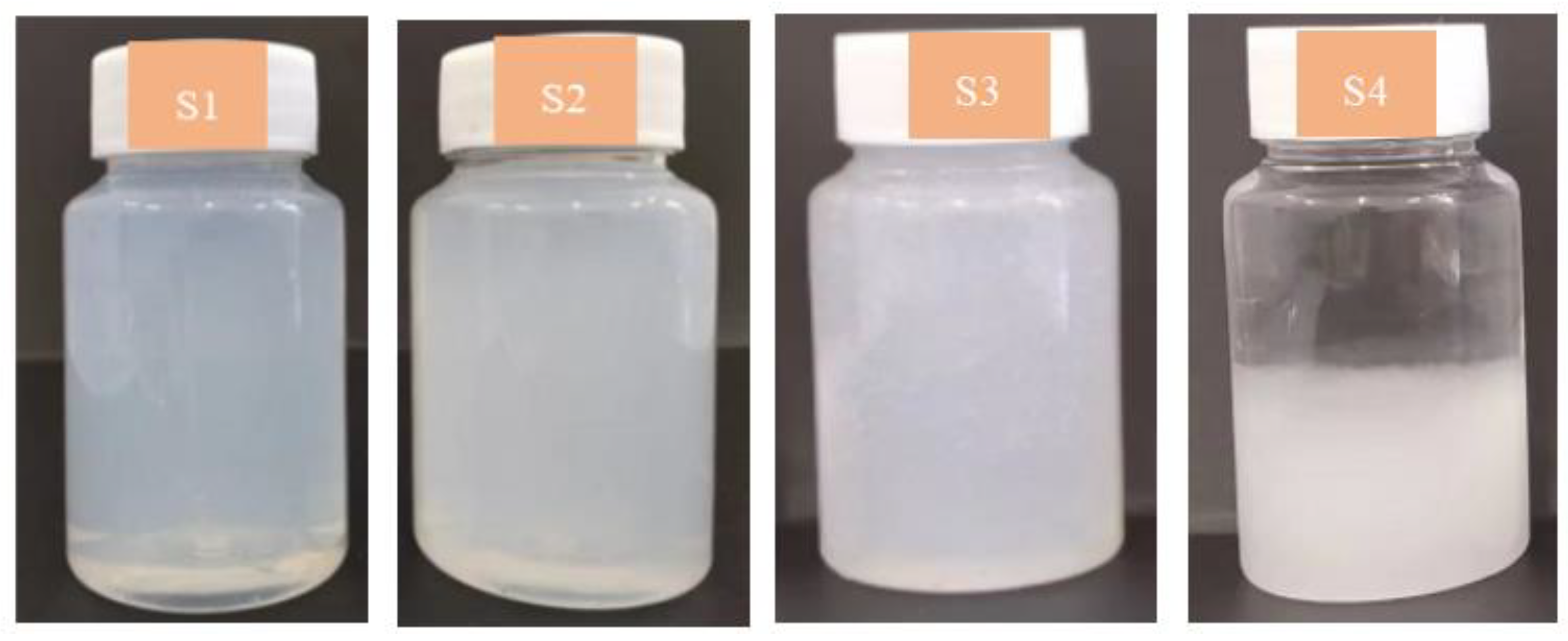
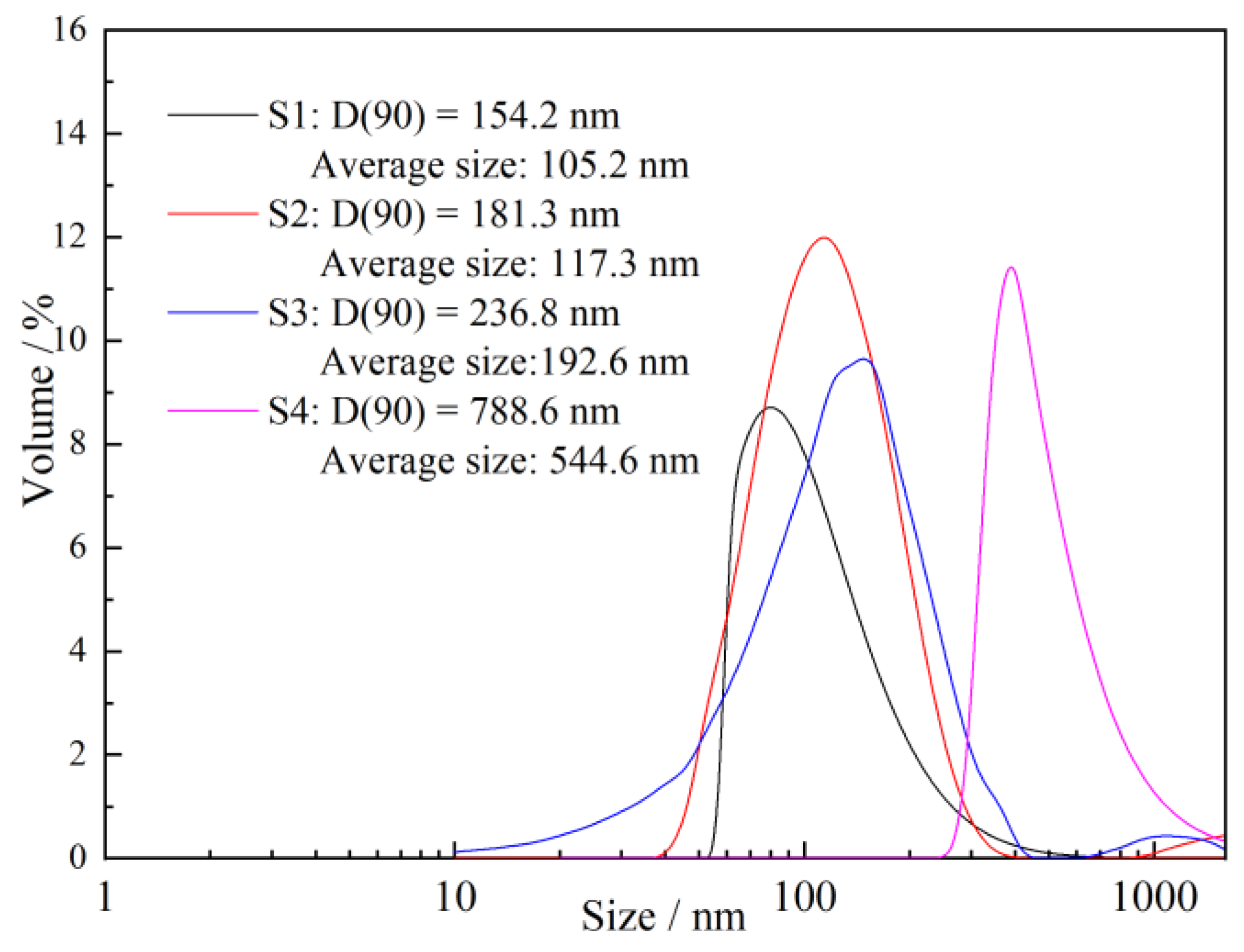




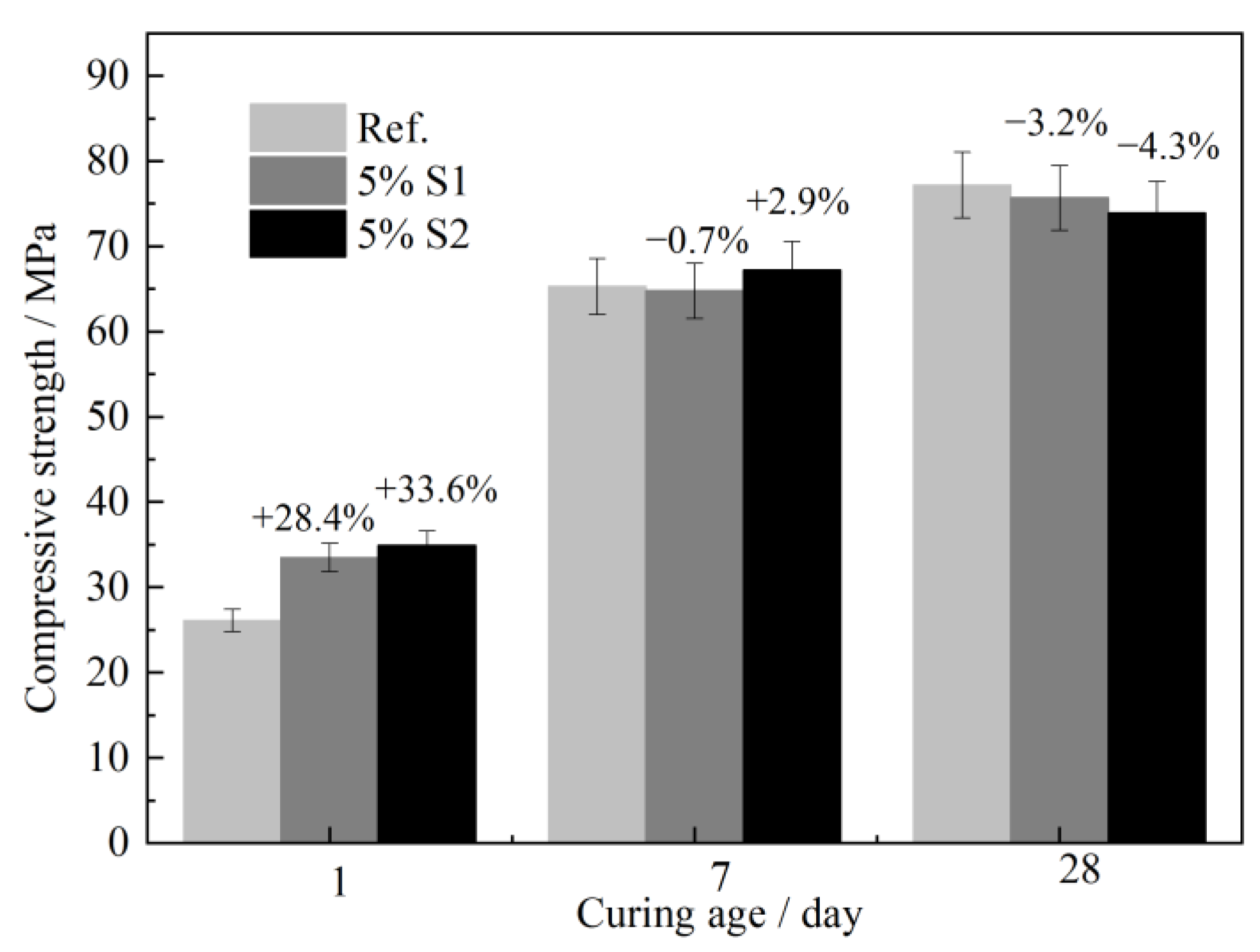

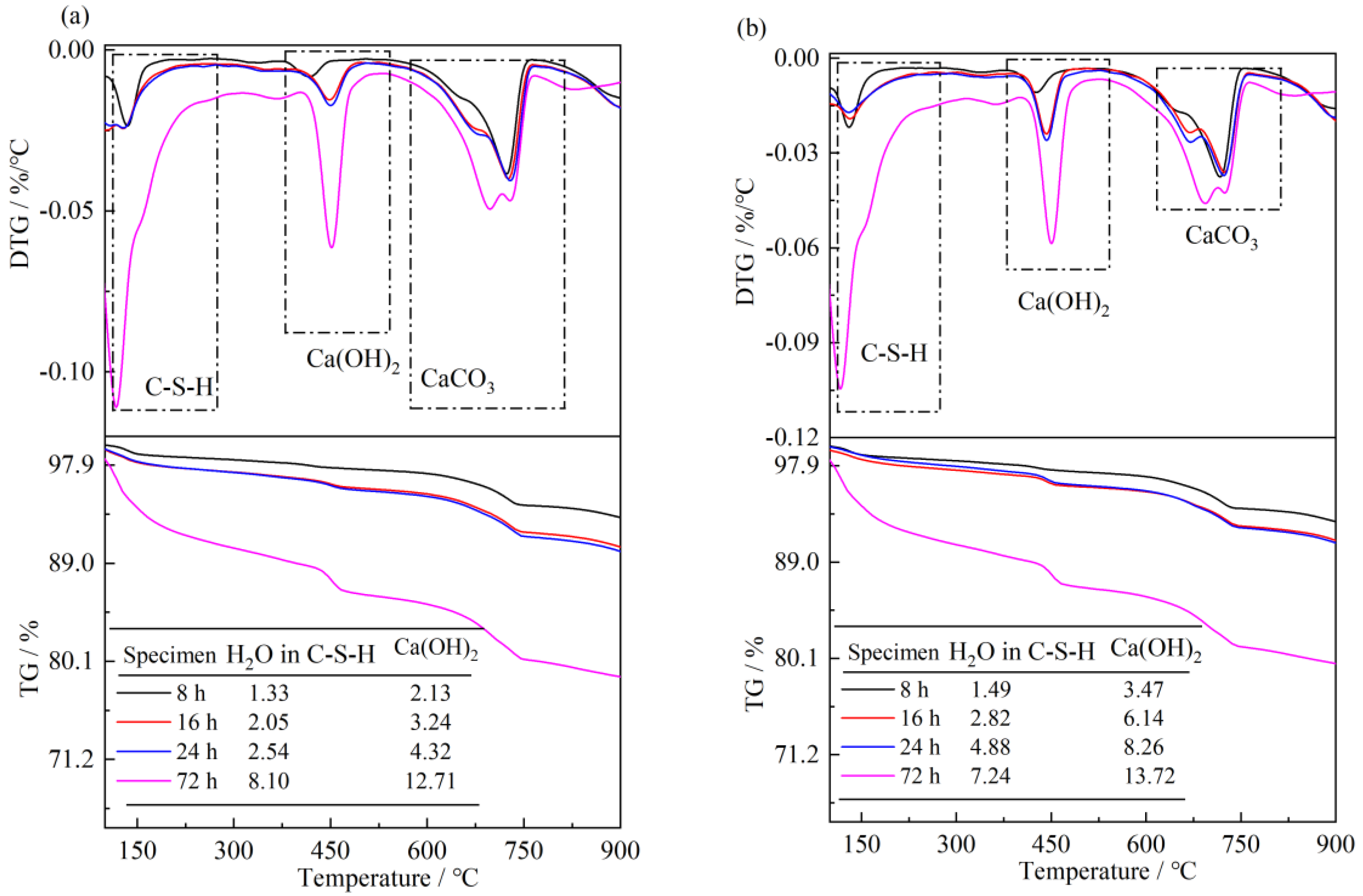

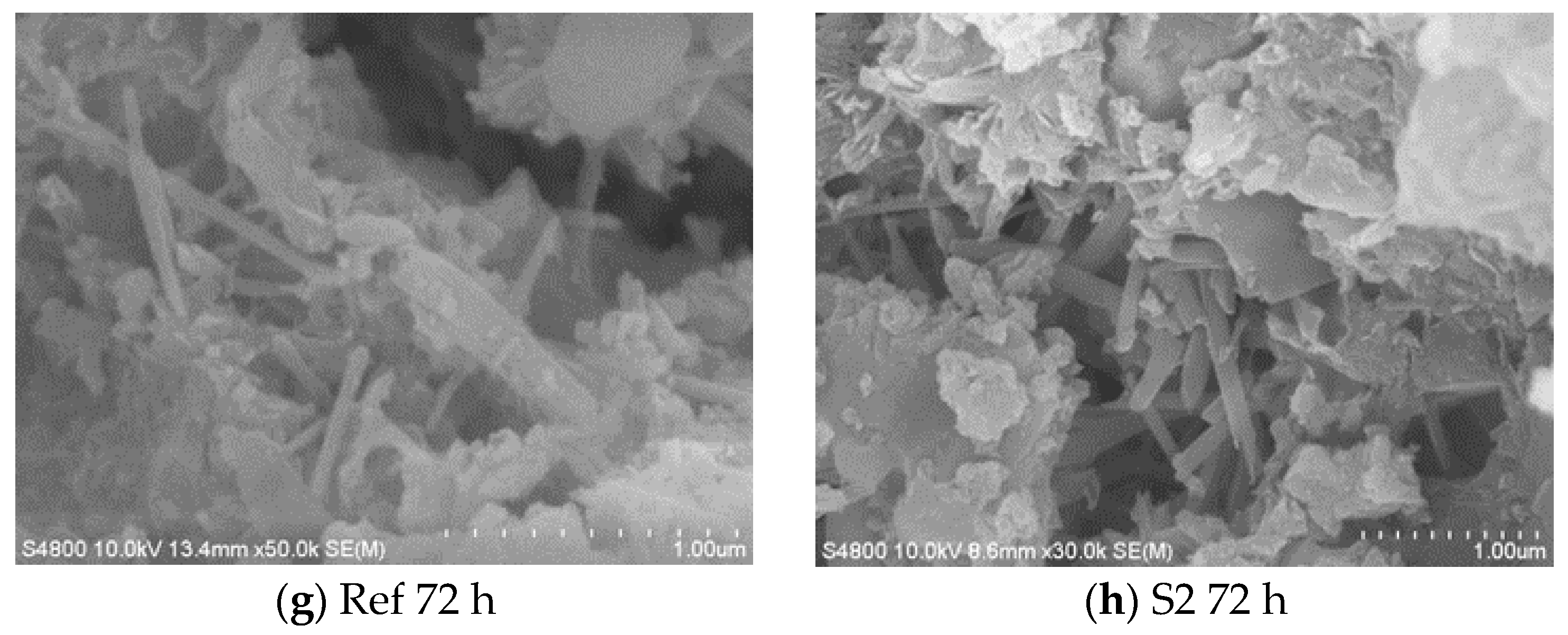
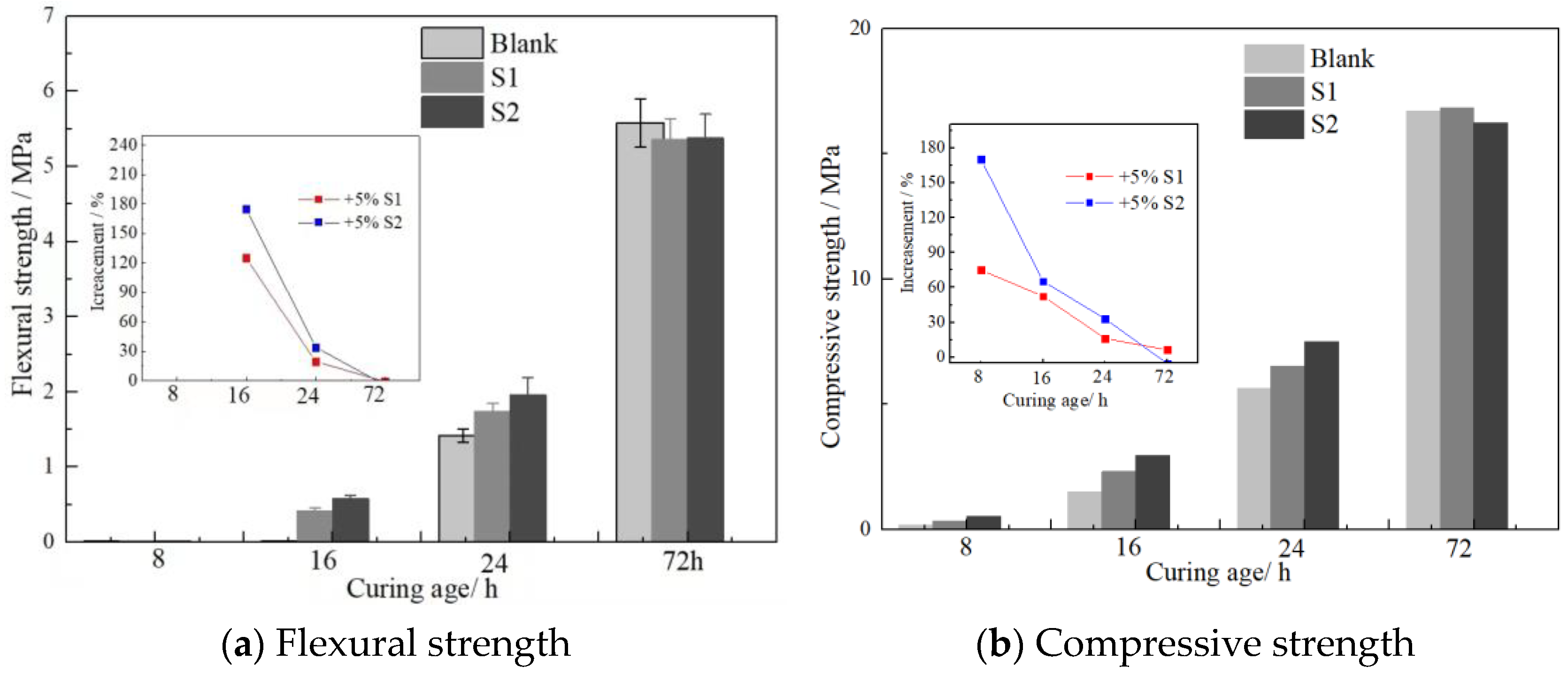
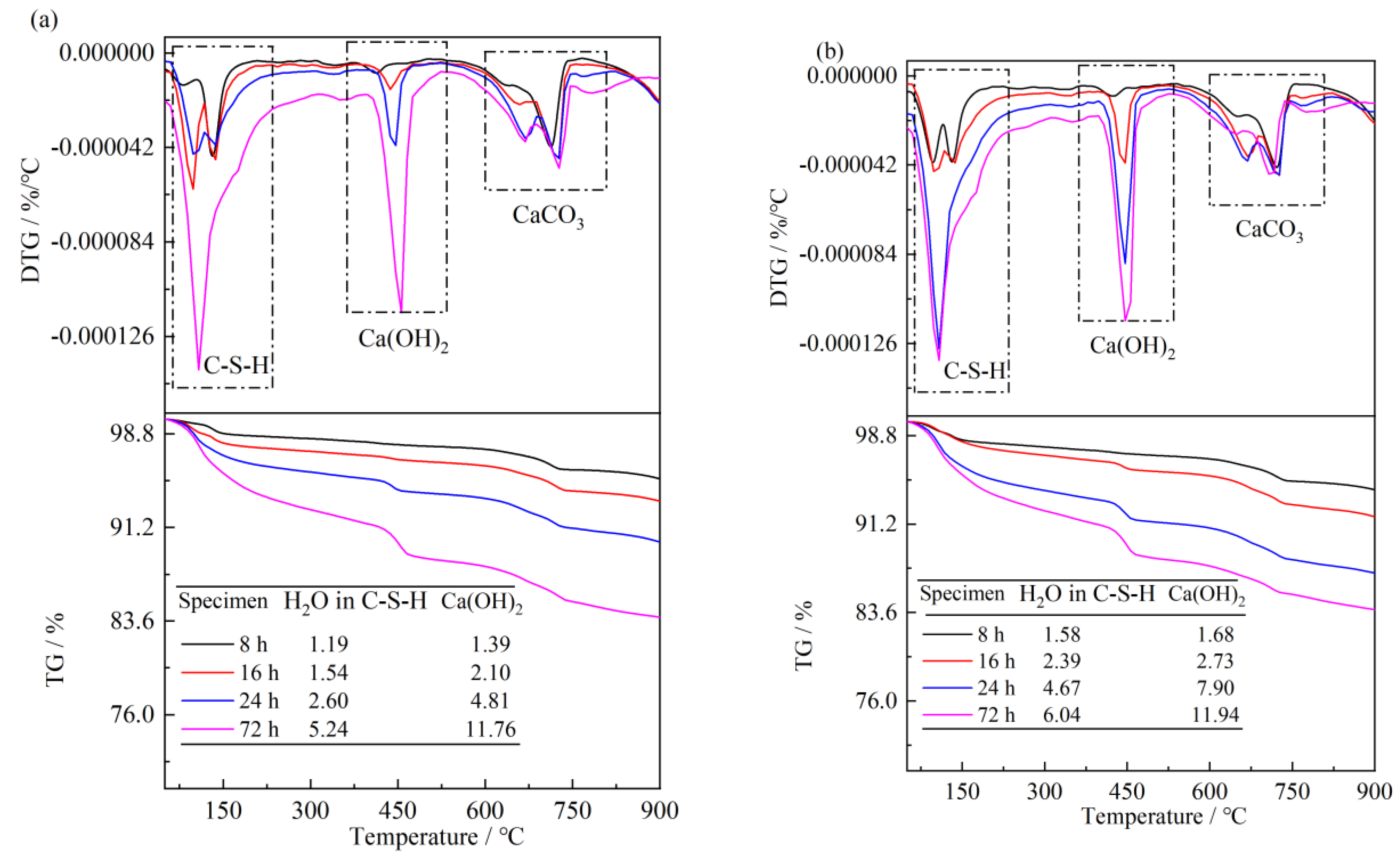
| SiO2 | CaO | MgO | Fe2O3 | Al2O3 | K2O | Na2O | SO3 | LOI |
|---|---|---|---|---|---|---|---|---|
| 20.31 | 62.58 | 2.93 | 3.73 | 4.38 | - | - | 2.45 | 1.58 |
| Specimen | Na2O | MgO | Al2O3 | SiO2 | P2O5 | K2O | CaO | Fe2O3 |
|---|---|---|---|---|---|---|---|---|
| Grade IFly ash | 1.75 | 1.46 | 26.54 | 48.92 | 0.15 | 2.03 | 4.82 | 4.59 |
| Ultrafine slag | - | 8.43 | 1.24 | 32.21 | - | - | 37.52 | 15.28 |
| Mix Design | Cement | Fly ash | Slag | Gravel | Sand | Water | AEa | n-C-S-Hb |
|---|---|---|---|---|---|---|---|---|
| H0 | 384 | 72 | 24 | 1020 | 724 | 136 | 2.4 | 0 |
| H1 | 384 | 72 | 24 | 1020 | 724 | 136 | 2.4 | 24, S1 |
| H2 | 384 | 72 | 24 | 1020 | 724 | 136 | 2.4 | 24, S2 |
| Band | Specimen | Assigned to | |||
|---|---|---|---|---|---|
| S1 | S2 | S3 | S4 | ||
| a | 449 | 452 | 451 | 451 | ν4Si–O (SiO4Td) |
| b | 671 | 671 | 671 | 670 | ν4Si–O–Si |
| c | 968 | 970 | 972 | 966 | ν3Si–O(C–S–H) Q2 |
| d | 1489 | 1471 | 1426 | 1427 | ν3CO (CO32-) |
| e | 1641 | 1640 | 1639 | 1640 | ν3OH (H2O) |
Disclaimer/Publisher’s Note: The statements, opinions and data contained in all publications are solely those of the individual author(s) and contributor(s) and not of MDPI and/or the editor(s). MDPI and/or the editor(s) disclaim responsibility for any injury to people or property resulting from any ideas, methods, instructions or products referred to in the content. |
© 2023 by the authors. Licensee MDPI, Basel, Switzerland. This article is an open access article distributed under the terms and conditions of the Creative Commons Attribution (CC BY) license (https://creativecommons.org/licenses/by/4.0/).
Share and Cite
Fang, Y.; Zhang, L.; Li, L.; Zhao, M.; Wang, Q.; Mei, Y. Preparation of Nano-Sized C-S-H and Its Acceleration Mechanism on Portland Cement Hydration at Different Temperatures. Materials 2023, 16, 3484. https://doi.org/10.3390/ma16093484
Fang Y, Zhang L, Li L, Zhao M, Wang Q, Mei Y. Preparation of Nano-Sized C-S-H and Its Acceleration Mechanism on Portland Cement Hydration at Different Temperatures. Materials. 2023; 16(9):3484. https://doi.org/10.3390/ma16093484
Chicago/Turabian StyleFang, Yanfeng, Limin Zhang, Li Li, Mingyu Zhao, Qing Wang, and Yong Mei. 2023. "Preparation of Nano-Sized C-S-H and Its Acceleration Mechanism on Portland Cement Hydration at Different Temperatures" Materials 16, no. 9: 3484. https://doi.org/10.3390/ma16093484






